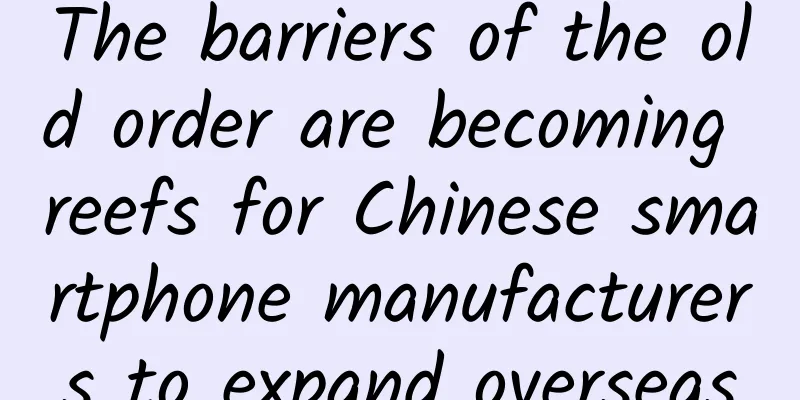The barriers of the old order are becoming reefs for Chinese smartphone manufacturers to expand overseas

|
Within a week, Xiaomi and OnePlus, two Chinese smartphone manufacturers that have risen fastest in recent years, were banned from selling their products in India by the Delhi High Court. Previously, both companies had clearly expressed their interest in the Indian market and had achieved good initial results. This is a very intriguing phenomenon. Xiaomi and OnePlus, as well as the "Honor" series of Huawei, which has gained fame, have the typical characteristics of the rapid rise of Chinese smartphone manufacturers in recent years: high growth beyond the normal speed, rapidly gathering fan effect, extremely flat sales channels, near-perfect price-performance golden balance, international brand awareness and influence... The Indian market also has a series of highly "exploitable" characteristics: demographic dividend, the rapid migration of feature phones to smartphones has just begun, the first wave of smartphone "replacement tide" is sweeping, the imagination of the world's third largest smartphone market, the gradual popularization of 3G bandwidth, and consumers are generally price-sensitive... Therefore, there is no reason for China's rapidly rising generation of new smartphone players not to enter India. If we only stand on the principle of fair market competition, whether from the market fit to the previous emerging market operation experience, the Indian market should belong to the new Chinese smartphone players. Isn't that right? In early September, Xiaomi held a press conference in India and launched the Redmi series of mobile phones in cooperation with Flipkart, a local e-commerce platform in India. The number of pre-orders exceeded 500,000 in more than three months. Recently, Xiaomi's shipments in India have climbed to 150,000 per week. Xiaomi is even optimistic that it will announce a sales milestone of 1 million units in India at some point in early 2015. In early December, OnePlus and Amazon held a press conference in New Delhi to enter the Indian market. The number of pre-orders on the official website exceeded 200,000 on the same day. Some people predict that based on the current shipments of smartphones in India, Xiaomi has taken at least 5% of the market share. Based on this calculation, from the pre-order volume, OnePlus can take 2-4% of the local smartphone market share in India. So, the sales bans came one after another: In early December, Xiaomi was first ordered by the Delhi High Court to suspend sales in India because Ericsson sued Xiaomi for infringing its patents. On December 16, with the support of Qualcomm, Xiaomi devices using Qualcomm SoCs were able to continue to be sold in India, unaffected by the ban until the next hearing date of the Ericsson v. Xiaomi case - February 5, 2015. In dealing with OnePlus, the Delhi High Court accepted the appeal of Indian mobile phone manufacturer Micromax and announced that OnePlus phones were banned from engaging in any marketing, sales and other work in India. The reason was that OnePlus phones violated the system licensing agreement exclusively signed between Micromax and Cyanogenmod (hereinafter referred to as CM), and privately sold OnePlus phones equipped with CM systems, while CM had previously been OnePlus's global operating system partner. The two bans came from the same Indian local high court. The reasons are different. It is boring to simply speculate on the motives, but you can still find similar logic behind the two bans: For Xiaomi, its most direct killer weapon to enter the Indian market is its flat sales channel and "golden cost-effective" products. The local price of Redmi 1/1S in India is lower than any smartphone with similar configuration on the market; and the core of Ericsson's lawsuit against Xiaomi for infringement is precisely the key patents of communication technology standards - that is, the upstream 3G/4G communication technology chip solutions. This part of the patent will directly affect the cost of each mobile phone, and the cost will inevitably affect the pricing; although Xiaomi can still sell devices using Qualcomm chip solutions in India, the "cheaper" solution is obviously MTK's solution, which is precisely the key part of this ban. If Xiaomi eventually has to pay Ericsson billions of dollars in patent fees, it will inevitably have a far-reaching impact on Xiaomi's entire strategy in India and even pricing. Let's look at OnePlus. The operating system customized with CM in overseas markets is a highlight of OnePlus and is also popular among users in various countries and regions. However, the crux of the lawsuit filed by Indian local mobile phone manufacturer Micromax against OnePlus for violating the exclusive agreement lies in the CM operating system. Although OnePlus officially stated that the global cooperation agreement between OnePlus and CM does not exclude any single market outside mainland China, if OnePlus eventually has to sell other operating systems in India (such as Android native operating systems or other customized ROMs), it is obvious that it will lose a very important core advantage in the global market. So the facts are clear: whether in the name of patent infringement or violation of exclusive cooperation agreements, the emerging Chinese smartphone players in India are being hit at the core of their competitiveness - local Indian regulators are hitting these Chinese players where they are weak. In fact, every player has his own Achilles' heel. In the market dominated by the old order overprotected by complex cross-patent licensing agreements, and in the cooperative relationships overpackaged by "exclusive licensing" and full of legal traps, the Achilles' heel of new players who are excluded from these game rules and complicated relationships is particularly conspicuous. The reason why these new players are found to have Achilles' heel by Ericsson, Nokia and even Micromax is not because they lack moral awareness and business ethics, but because they are too young, too fearless, too focused on products, operations and expansion, which seem to be more fun and ambitious, and they are at a loss for the endless tricks in the old order that will always affect and interfere with their ambitions, and they lack the awareness and experience of early warning. We have said in an article that Xiaomi is a rare company in the field of smartphones that lacks patent and intellectual property arsenal ammunition. OnePlus, which has risen rapidly within a year, also lacks sufficient experience in dealing with the legal traps behind these patent protections and exclusive agreement protections. Although some people from Xiaomi told me privately that they have applied for thousands of international patents and intellectual property protections in the past two years, and also plan to make some moves in the field of patent cross-licensing. However, there is a very long time window for the application and approval of international patents. During this window period, the patent war between Xiaomi and other players who are poorly protected or even overprotected by patents can only be a hand-to-hand fight. Let's look at Ericsson. It always appears "just right" in any patent war battlefield where it is needed. In the second half of 2012, when Samsung smartphones were sweeping the United States, Ericsson suddenly sued Samsung in the United States for infringing its patents and asked the court to completely ban the sale of Samsung smart devices in the United States. This ban was partially effective and had a serious impact on Samsung's expansion in the United States. It was not until early 2014 that Ericsson signed a new cross-licensing agreement with Samsung, and Samsung itself began to face more structural problems. The US market is one of the most important overseas markets for Samsung. It encountered Ericsson's patent sniping there, and the beneficiaries were local companies including Motorola and Apple; this time, in India, one of Xiaomi's most important overseas markets, Ericsson once again took action in the name of patent infringement. Which of its partners will benefit? Patents and exclusive licenses are weapons and moats that must be mastered as soon as possible for emerging players; for the masters of the old order, they are the swords and spears that prevent the rapid rise of emerging players, and are the cornerstones of their survival and the last refuge. Patent licensing and exclusive agreements have nothing to do with business ethics, but only about business interests and the game of offense and defense. To some extent, when Ericsson, Micromax and the Delhi High Court of India take new measures to set up barriers for Xiaomi and OnePlus, we feel that the situation of Xiaomi and OnePlus is no different from that of Uber, Yidao and Didi Kuaidi, which are being suppressed and restricted by regulators in the United States, China, India and other places. Xiaomi and OnePlus cannot ignore this long and desperate patent war and intellectual property war. But perhaps Google is the best example: as an Internet company and a destroyer of the old order, it encountered various lawsuits and restrictions in Europe and the United States in its early years due to its lack of patents in the field of mobile communication technology, until it acquired Motorola and obtained a large number of mobile communication patents. Now at least it can do one thing, that is, when faced with various types and faces of market free competition barrier builders and protectors, it can take up arms and fight them. Yes, in India, take up arms and fight them. |
<<: Mobile and PC management: a difficult but unstoppable path to merger
>>: A brief analysis of the 2014 Open Platform White Paper: 5 tips for mobile app operations
Recommend
Strong cold front is coming! Will this year be a warm winter or a cold winter? The latest analysis from the National Climate Center →
According to the Central Meteorological Observato...
QQ21 years old: How to make money from this generation of young people
Are you still using QQ now? If we use 400 million...
Konka's Internet Revolution: Returning the Living Room to the TV
The American TV series "House of Cards"...
When taking over a new project, how can we promote it so that it can quickly gain volume?
Let me share with you today: What are the methods...
A 6.8-magnitude earthquake struck Luding, Sichuan! Save! An effective guide to escaping and self-rescue in the event of an earthquake
According to the official measurement of China Ea...
Three types of invalid clicks that you must correctly understand in Baidu bidding!
Invalid clicks are the most data-interfering fact...
Lenovo launches P90, the world's first Intel 64-bit quad-core mobile phone
At CES 2015, Lenovo released the first mobile pho...
Why did human evolution move towards the pursuit of intelligence rather than physical strength?
Many people believe that mental labor is more adv...
New Lantu Dreamer: Redefine the MPV industry standard and create a dream mobile castle
In the new energy vehicle market, with the increa...
Zhang Xiaolong: Get out of loneliness
[[127969]] Today, as the commercial value of WeCh...
Gentle White is Not White · Douyin 0-cost project: single-day income of 500, no work release, no account maintenance [video course]
Gentle White is Not White · Douyin 0-cost project...
Monks and tigers in close proximity? The horrifying truth behind Thailand's tiger temple scandal
Wat Paluan Tabu in Kanchanaburi Province in weste...
An inventory of 3 common ways to play in social networks!
There are many different ways to play in a commun...
What happened with Liuli unilaterally terminating the contract with Mango TV? What is the specific situation?
What happened with Liuli unilaterally terminating...
Fermentation gives yogurt its "magic", but probiotics may not have the "magic"
In daily life, yogurt is a favorite of many peopl...









